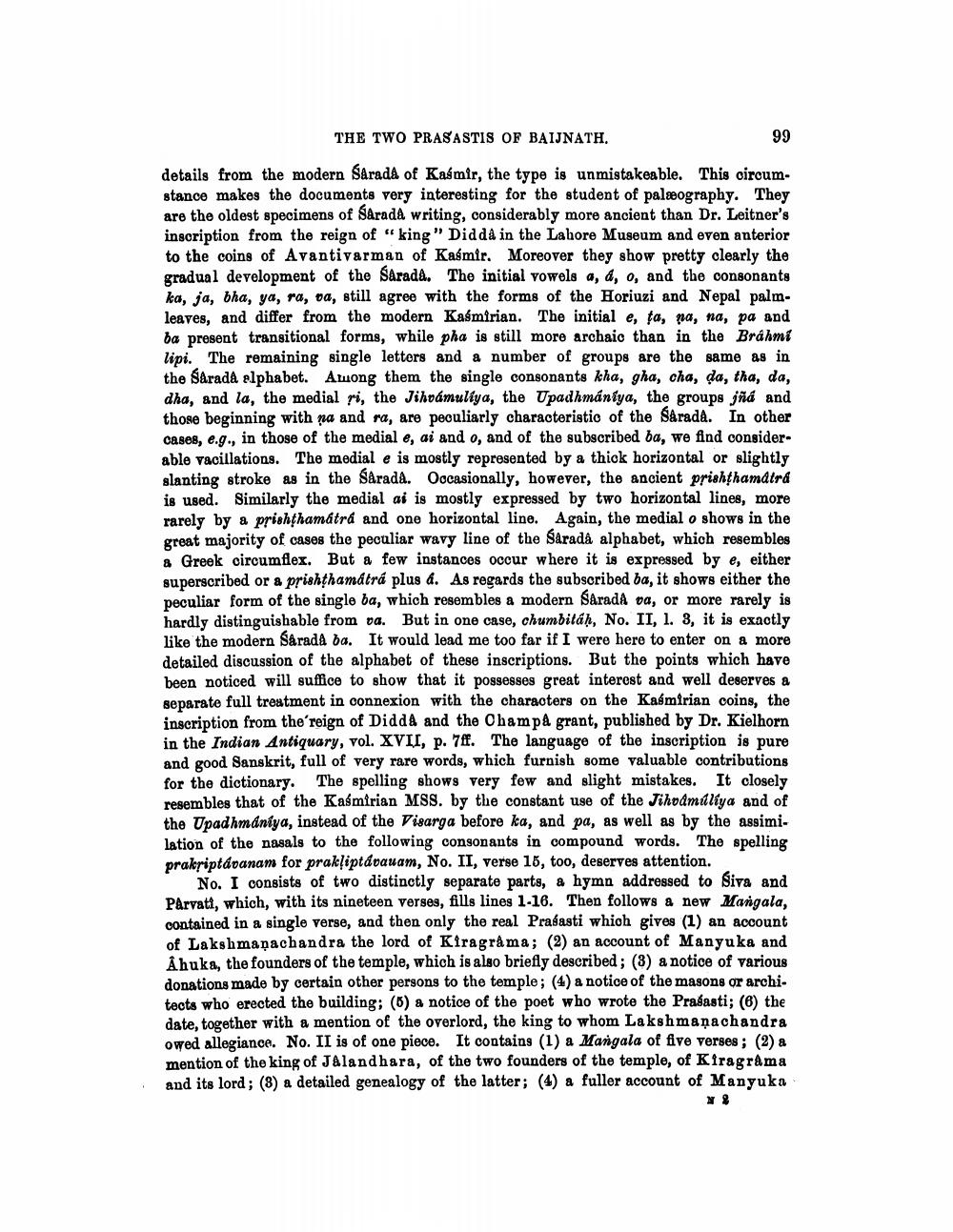________________
THE TWO PRASASTIS OF BAIJNATH.
99
details from the modern Sarada of Kasmir, the type is unmistakeable. This circumstance makes the documents very interesting for the student of palæography. They are the oldest specimens of Sarada writing, considerably more ancient than Dr. Leitner's inscription from the reign of "king" Didda in the Lahore Museum and even anterior to the coins of Avantivarman of Kasmir. Moreover they show pretty clearly the gradual development of the Sarada. The initial vowels a, a, o, and the consonants ka, ja, bha, ya, ra, va, still agree with the forms of the Horiuzi and Nepal palmleaves, and differ from the modern Kasmirian. The initial e, ta, na, na, pa and ba present transitional forms, while pha is still more archaio than in the Brahmi lipi. The remaining single letters and a number of groups are the same as in the Sarada elphabet. Among them the single consonants kha, gha, cha, da, tha, da, dha, and la, the medial ri, the Jihrámuliya, the Upadhmánlya, the groups jñá and those beginning with pa and ra, are peculiarly characteristic of the Sarada. In other cases, e.g., in those of the medial e, ai and o, and of the subscribed ba, we find considerable vacillations. The medial e is mostly represented by a thick horizontal or slightly glanting stroke as in the Sarada. Oocasionally, however, the ancient prishthamdird is used. Similarly the medial ai is mostly expressed by two horizontal lines, more rarely by a prishthamátrá and one horizontal line. Again, the medial o shows in the great majority of cases the peculiar wavy line of the Sarada alphabet, which resembles & Greek circumflex. But a few instances occur where it is expressed by e, either superscribed or a prishthamdtra plus d. As regards the subscribed ba, it shows either the peculiar form of the single ba, which resembles a modern Sarada da, or more rarely is hardly distinguishable from va. But in one case, chumbitáh, No. II, 1. 3, it is exactly like the modern Sarada ba. It would lead me too far if I were here to enter on a more detailed discussion of the alphabet of these inscriptions. But the points which have been noticed will suffice to show that it possesses great interest and well deserves a separate full treatment in connexion with the characters on the Kasmirian coins, the inscription from the reign of Didda and the Champa grant, published by Dr. Kielhorn in the Indian Antiquary, vol. XVII, p. 7ff. The language of the inscription is pure and good Sanskrit, full of very rare words, which furnish some valuable contributions for the dictionary. The spelling shows very few and slight mistakes. It closely resembles that of the Kasmirian MSS. by the constant use of the Jihvdmdliya and of the Upadhmaniya, instead of the Visarga before ka, and pa, as well as by the assimi. lation of the nasals to the following consonants in compound words. The spelling prakriptávanam for prakliptávauam, No. II, verse 16, too, deserves attention.
No. I consists of two distinctly separate parts, a hymn addressed to Siva and Parvati, which, with its nineteen verses, fills lines 1-16. Then follows a new Mangala, contained in a single verse, and then only the real Prasasti which gives (1) an account of Lakshmanachandra the lord of Kiragrama; (2) an account of Manyuka and Åhuka, the founders of the temple, which is also briefly described; (3) a notice of various donations made by certain other persons to the temple; (4) a notice of the masons or archi. tects who erected the building; (6) a notice of the poet who wrote the Prasasti; (6) the date, together with a mention of the overlord, the king to whom Lakshmanachandra owed allegiance. No. II is of one piece. It contains (1) a Mangala of five verses; (2) a mention of the king of Jalandhara, of the two founders of the temple, of Kiragrama and its lord; (8) a detailed genealogy of the latter; (4) a fuller account of Manyuka




